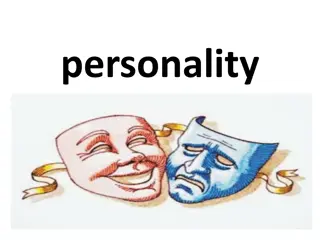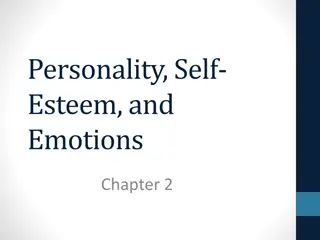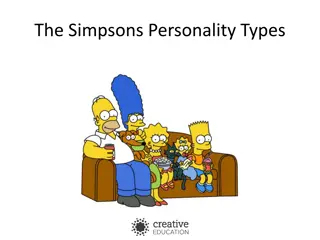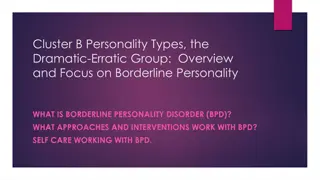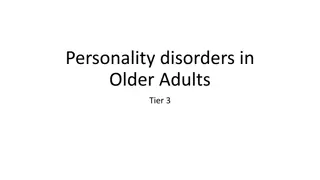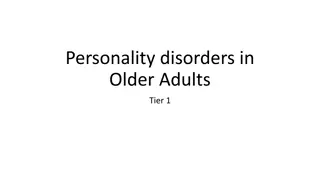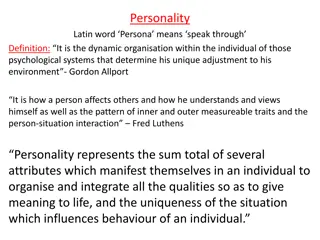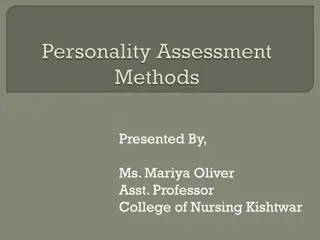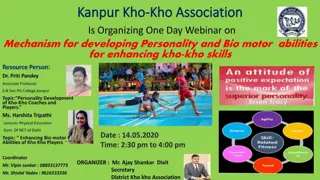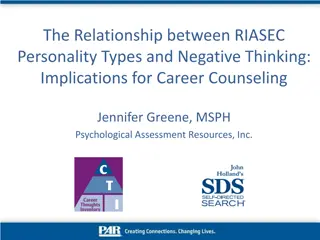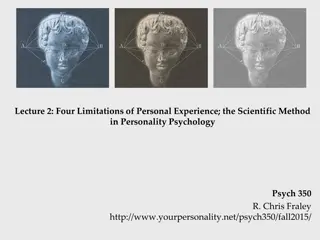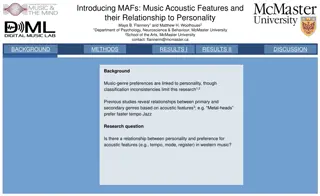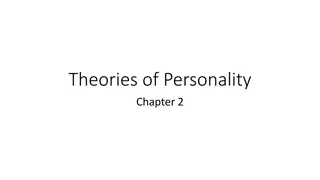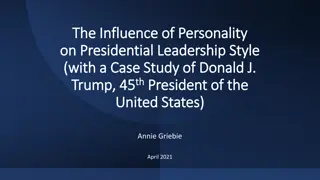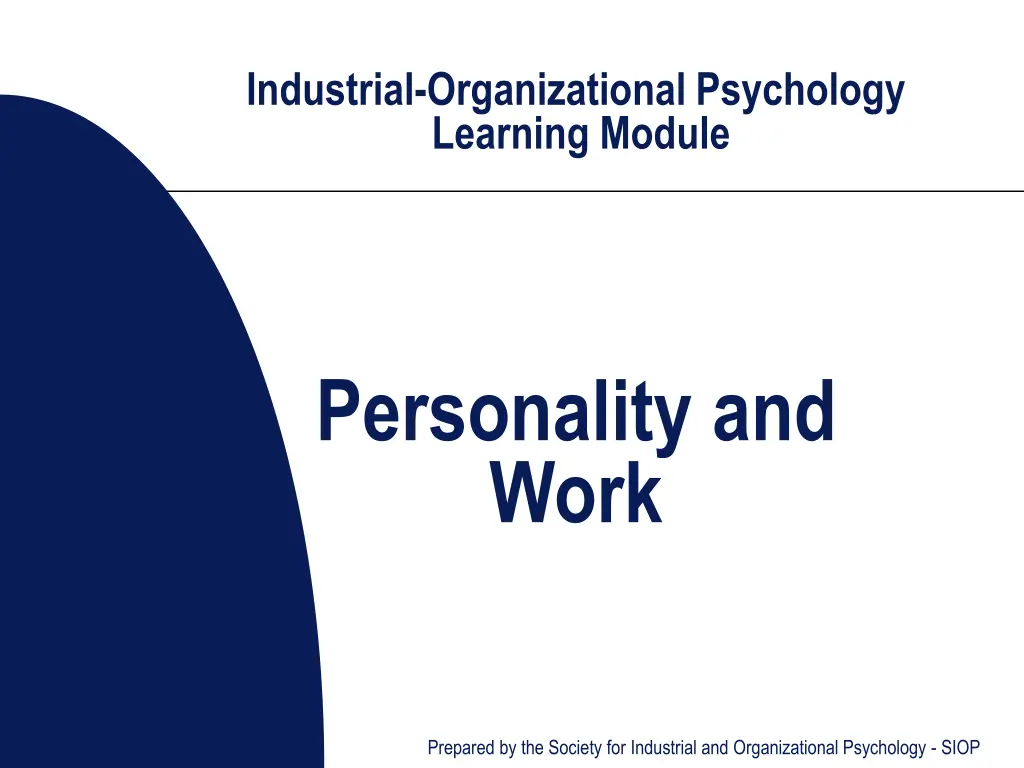
Understanding Industrial-Organizational Psychology: Personality in the Workplace
Explore the fascinating realm of personality in the workplace through the lens of industrial-organizational psychology. Delve into the history, theories, and impact of personality on job performance and organizational dynamics. Learn about the Five-Factor Model and how it shapes our understanding of personality across cultures. Uncover the role of personality assessment tools in decision-making by organizational managers.
Download Presentation

Please find below an Image/Link to download the presentation.
The content on the website is provided AS IS for your information and personal use only. It may not be sold, licensed, or shared on other websites without obtaining consent from the author. If you encounter any issues during the download, it is possible that the publisher has removed the file from their server.
You are allowed to download the files provided on this website for personal or commercial use, subject to the condition that they are used lawfully. All files are the property of their respective owners.
The content on the website is provided AS IS for your information and personal use only. It may not be sold, licensed, or shared on other websites without obtaining consent from the author.
E N D
Presentation Transcript
Industrial-Organizational Psychology Learning Module Personality and Work Prepared by the Society for Industrial and Organizational Psychology - SIOP
Lesson Objectives At the end of this lecture, you should understand: What is meant by personality. A brief history of personality theory and research. The elements of the most commonly accepted model of personality - the Five-Factor Model ( Big Five or FFM ). How personality has been shown to affect job performance and other work-related outcomes. Why and how organizational managers use personality assessment as a tool in decision-making. Prepared by the Society for Industrial and Organizational Psychology - SIOP
What is Personality? Internal perspective: Processes within an individual that explain why he or she behaves in characteristic ways. Attitudes, emotions, ways of thinking Fairly stable across time and situations Partly inherited External perspective: How the individual is perceived by others that he or she interacts with (reputation). She has a great personality! Shaped by two fundamental motives related to social interaction Getting along with others (cooperation) Getting ahead of others (competition)
Personality Theory and Research Allport: Cardinal and Central Traits Cattell: Sixteen Personality Factors Eysenck: Extraversion, Neuroticism, and Psychoticism Prepared by the Society for Industrial and Organizational Psychology - SIOP
Personality, Organizations, and the Organization of Personality Early researchers believed the personality-job performance relationship was weak. Reasons: Comparatively weak analytic techniques. Inappropriate measures (most used psychopathology inventories, e.g., MMPI). No theoretical framework on which to base research findings. The belief that behavior is determined more by situations than by traits (Mischel,1968). Research and theoretical innovations that rehabilitated personality in late 80 s, early 90 s. Meta-analysis: A new quantitative method for summarizing research findings. The Five-Factor Model: A new organizing taxonomy for personality structure (The Big Five).
The Five-Factor Model Premise: Personality can be efficiently described with five relatively independent trait dimensions. Model derived from factor-analytic studies of much larger sets of traits. Factor analysis: A method for reducing a large set of data into something interpretable Allport & Odbert (1936): Identified more than 18,000 trait terms in unabridged dictionary Eventually factor analyzed into five dimensions Five-factor model reproduced across many cultures and languages (Saucier, Hampson, & Goldberg, 2000). Research evidence points to the heritability (Rowe, 1997) and stability (Costa & McCrae, 1997) of the FFM.
The Five-Factor Model The Five Factors and their Characteristics: Extraversion: Assertive, competitive, positive emotionality, sociable Agreeableness: Warm, likeable, gentle, cooperative Conscientiousness: Orderly, dependable, industrious, disciplined Emotional Stability: Relaxed, free from anxiety, depression, negative emotionality Openness to Experience: Creative, cultured, intellectual, perceptive
The Five-Factor Model and Job Performance: Research Findings Summary of meta-analytic findings (Barrick & Mount, 1991): Conscientiousness and Emotional Stability are the best personality predictors of job performance across nearly all jobs. Extraversion and Agreeableness are important in jobs requiring a high degree of interpersonal work Less consistent evidence for Openness to Experience Personality has been shown to predict: Job performance and results (e.g. $ sales volume) Job satisfaction Training performance Leadership .and many more important job-related behaviors and attitudes
How Does Personality Affect Job Performance? Theory and research show that Big Five factors impact motivation, which in turn affects performance. For example Self-efficacy Conscientiousness Performance Goals Thus, personality s effect on performance may be fully or partially (dotted line) mediated by motivation
Why Should Organizations Test Personality? Personality predictsaspects of job performance that may not be strongly related to knowledge, skills or abilities. Incremental validity Predicts what a person will do, as opposed to what they can do. Contextual job performance (Borman & Motowidlo, 1993) Organizational Citizenship Behaviors: Willingness to go above and beyond the call of duty Unlike other selection tools, little or no evidence of adverse impact (different selection ratios between demographic groups).
Personality in Selection Decisions: A Case Study You ve been hired to design a selection system for customer service workers at McToxic Pizza Step 1: Conduct a thorough Job Analysis You discover that high-performers are friendly, dependable, and low in imagination Step 2: Refer worker attributes to a validated model of personality (e.g., the Big Five) Friendly: Agreeableness; Dependable: Conscientiousness; Unimaginative: (Low) Openness to Experience. Step 3: Incorporate a personality test as one factor guiding selection decisions DO NOT base selection decisions solely on a single test score of any kind!!
How Accurately Can You Describe Yourself? 1 2 Slightly Neither Slightly Accurate Inaccurate Accurate 3 4 5 Inaccurate 1. Bashful 2. Bold 3. Careless 4. Cold 5. Complex 6. Cooperative 7. Creative 8. Deep 9. Disorganized 10. Efficient 11. Energetic 12. Envious 13. Extraverted 14. Fretful 15. Harsh 16. Imaginative 17. Inefficient 18. Intellectual 19. Jealous 20. Kind 21. Moody 22. Organized 23. Philosophical 24. Practical 25. Quiet 26. Relaxed 27. Rude 28. Shy 29. Sloppy 30. Sympathetic 31. Systematic 32. Talkative 33. Temperamental 34. Touchy 35. Uncreative 36. Unenvious 37. Unintellectual 38. Unsympathetic 39. Warm 40. Withdrawn
Reverse score items: 1, 3, 4, 9, 12, 14, 15, 17, 19, 21, 25, 27, 28, 29,33, 34, 35, 37, 38, 40 1 = 5 2 = 4 3 = 3 4 = 2 5 = 1 Sum items: 1, 2, 11, 13, 25, 28, 32, 40 = Factor I 12, 14, 19, 21, 26, 33, 34, 36 = Factor II 4, 6, 15, 20, 27, 30, 38, 39 = Factor III 3, 9, 10, 17, 22, 24, 29, 31 = Factor IV 5, 7, 8, 16, 18, 23, 35, 37 = Factor V
Extraversion (Factor I) 1. Bashful 2. Bold 3. Careless 4. Cold 5. Complex 6. Cooperative 7. Creative 8. Deep 9. Disorganized 10. Efficient 11. Energetic 12. Envious 13. Extraverted 14. Fretful 15. Harsh 16. Imaginative 17. Inefficient 18. Intellectual 19. Jealous 20. Kind 21. Moody 22. Organized 23. Philosophical 24. Practical 25. Quiet 26. Relaxed 27. Rude 28. Shy 29. Sloppy 30. Sympathetic 31. Systematic 32. Talkative 33. Temperamental 34. Touchy 35. Uncreative 36. Unenvious 37. Unintellectual 38. Unsympathetic 39. Warm 40. Withdrawn
Emotional Stability (Factor II) 1. Bashful 2. Bold 3. Careless 4. Cold 5. Complex 6. Cooperative 7. Creative 8. Deep 9. Disorganized 10. Efficient 11. Energetic 12. Envious 13. Extraverted 14. Fretful 15. Harsh 16. Imaginative 17. Inefficient 18. Intellectual 19. Jealous 20. Kind 21. Moody 22. Organized 23. Philosophical 24. Practical 25. Quiet 26. Relaxed 27. Rude 28. Shy 29. Sloppy 30. Sympathetic 31. Systematic 32. Talkative 33. Temperamental 34. Touchy 35. Uncreative 36. Unenvious 37. Unintellectual 38. Unsympathetic 39. Warm 40. Withdrawn
Agreeableness (Factor III) 1. Bashful 2. Bold 3. Careless 4. Cold 5. Complex 6. Cooperative 7. Creative 8. Deep 9. Disorganized 10. Efficient 11. Energetic 12. Envious 13. Extraverted 14. Fretful 15. Harsh 16. Imaginative 17. Inefficient 18. Intellectual 19. Jealous 20. Kind 21. Moody 22. Organized 23. Philosophical 24. Practical 25. Quiet 26. Relaxed 27. Rude 28. Shy 29. Sloppy 30. Sympathetic 31. Systematic 32. Talkative 33. Temperamental 34. Touchy 35. Uncreative 36. Unenvious 37. Unintellectual 38. Unsympathetic 39. Warm 40. Withdrawn
Conscientiousness (Factor IV) 1. Bashful 2. Bold 3. Careless 4. Cold 5. Complex 6. Cooperative 7. Creative 8. Deep 9. Disorganized 10. Efficient 11. Energetic 12. Envious 13. Extraverted 14. Fretful 15. Harsh 16. Imaginative 17. Inefficient 18. Intellectual 19. Jealous 20. Kind 21. Moody 22. Organized 23. Philosophical 24. Practical 25. Quiet 26. Relaxed 27. Rude 28. Shy 29. Sloppy 30. Sympathetic 31. Systematic 32. Talkative 33. Temperamental 34. Touchy 35. Uncreative 36. Unenvious 37. Unintellectual 38. Unsympathetic 39. Warm 40. Withdrawn
Openness to Experience (Factor V) 1. Bashful 2. Bold 3. Careless 4. Cold 5. Complex 6. Cooperative 7. Creative 8. Deep 9. Disorganized 10. Efficient 11. Energetic 12. Envious 13. Extraverted 14. Fretful 15. Harsh 16. Imaginative 17. Inefficient 18. Intellectual 19. Jealous 20. Kind 21. Moody 22. Organized 23. Philosophical 24. Practical 25. Quiet 26. Relaxed 27. Rude 28. Shy 29. Sloppy 30. Sympathetic 31. Systematic 32. Talkative 33. Temperamental 34. Touchy 35. Uncreative 36. Unenvious 37. Unintellectual 38. Unsympathetic 39. Warm 40. Withdrawn
Caveats and Future Research Directions Is the Big Five the best model? It s a model of personality, not a theory Some research suggests that 3, 7, or 9 factor models best represent human personality Studies have shown greater predictive validity for finer-grained facets of personality - measure predictors and criteria at the same level. Are self-report personality tests accurate? Personality test-takers can distort responses when instructed to do so Most research suggests that distortion does not undermine validity of personality tests Again: How does personality affect performance? Are there other mechanisms besides motivation?
References General overview Barrick, M.R., & Ryan, A.M. (Eds.). (2003). Personality and work: Reconsidering the role of personality in organizations. San Francisco: Jossey Bass. Roberts, B.W., & Hogan, R. (Eds.). (2001). Personality psychology in the workplace. Washington, D.C.: American Psychological Association. Hogan, R. (1991). Personality and personality measurement. In M.D. Dunnette & L.M. Hough (Eds.), Handbook of industrial and organizational psychology (Vol 2). Palo Alto, CA: Consulting Psychologists Press. Hogan, R., Hogan, J., & Roberts, B.W. (1996). Personality measurement and employment decisions. American Psychologist, 51, 469-477. Meta-analyses Barrick, M.R., & Mount, M.K. (1991). The Big Five personality dimensions and job performance: A meta-analysis. Personnel Psychology, 44, 1-26. Hough, L.M., Eaton, N.L., Dunnette, M.D., Kamp, J.D., & McCloy, R.A. (1990). Criterion-related validities of personality constructs and the effect of response distortion on those validities. Journal of Applied Psychology, 75, 581-595. The Five-Factor Model Wiggins, J.S. (Ed.) (1996). The Five-Factor Model of personality. New York: Guilford. Saucier, G., Hampson, S.E., & Goldberg, L.R. (2000). Cross-language studies of lexical personality factors. In S.E. Hampson (Ed.), Advances in personality psychology (Vol. 1). Philadelphia: Taylor & Francis. Costa, P.T., & McCrae, R.R. (1997). Longitudinal stability in adult personality. In R. Hogan, J. Johnson, & S. Briggs (Eds.), Handbook of personality psychology. San Diego: Academic Press. Rowe, D.C. (1997). Genetics, Temperament, and personality. In R. Hogan, J. Johnson, & S. Briggs (Eds.), Handbook of personality psychology. San Diego: Academic Press.
References (cont) Personality, Motivation, and Performance Kanfer, R., & Ackerman, P.L. (2000). Individual differences in work motivation: Further explorations of a trait framework. Applied Psychology: An International Review, 49, 470-482. Judge, T.A., & Ilies, R. (2002). Relationship of personality to performance motivation: A meta-analytic review. Journal of Applied Psychology, 87, 797-807. Barrick, M.R., Mount, M.K., & Strauss, J.P. (1993). Conscientiousness and performance of sales representatives: Test of the mediating effects of goal-setting. Journal of Applied Psychology, 78, 715-722. Contextual Performance/OCB s Borman, W.C., & Motowidlo, S.J. (1993). Expanding the criterion domain to include elements of contextual performance. In N. Schmitt & W.C. Borman (Eds.), Personnel selection in organizations. San Francisco: Jossey Bass. Alternatives to the Big Five Block, J. (1995). A contrarian view of the five-factor approach to personality description. Psychological Bulletin, 117, 187-215. Schneider, R.J., Hough, L.M., & Dunnette, M.D. (1996). Broadsided by broad traits: How to sink science in five dimensions or less. Journal of Organizational Behavior, 17, 639-655. Incremental validity for facets Stewart, G.L. (1999). Trait bandwidth and stages of job performance: Assessing differential effects for conscientiousness and its subtraits. Journal of Applied Psychology, 84, 959-968. Distortion Hough, L.M. (1998). Effects of intentional distortion in personality measurement and evaluation of suggested palliatives. Human Performance, 11, 209-244.


